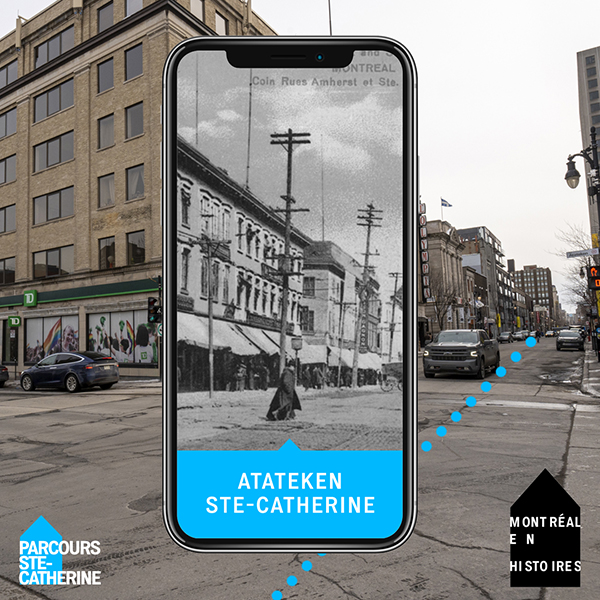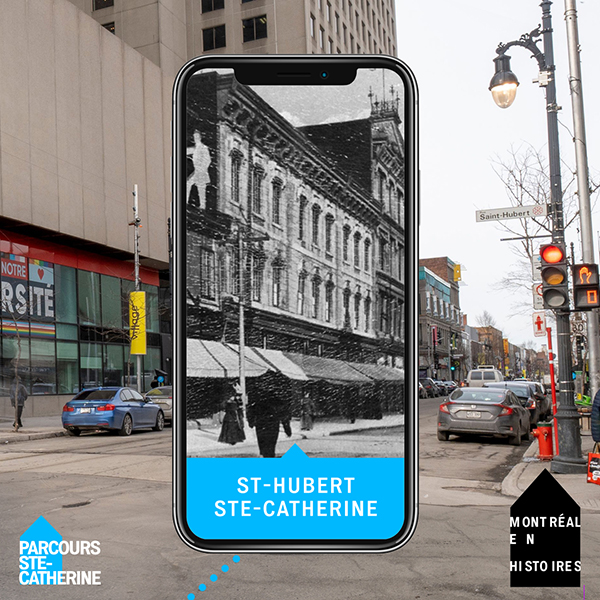Circuits
A digital journey through several chapters of Montreal’s history, experienced through different periods, events, figures, buildings and important public places. Interviews, anecdotes, podcasts, photos, videos or augmented realities are accessed through a mobile application. Routes vary in length and can be walked or cycled.
STE-CATHERINE CIRCUIT
A UNIQUE DIGITAL EXPERIENCE THAT TELLS THE STORY OF MONTREAL’S BIRTH, HISTORY AND KEY FIGURES
Discover or rediscover the legendary Sainte-Catherine Street through a podcasts, augmented realities and anecdotes on a new circuit available on the Montréal en Histoires app. With more than 40 points of interests along the way, the route goes from Atwater to Papineau streets.









OUR PARTNERS’ CIRCUITS

The Birth of the Railway
By the Middle Ages, vehicles drawn along wooden rails by humans or horses were already being used to facilitate moving heavy loads, particularly in the mining industry. As metallurgy developed in the 18th century, rails started being made from iron and steel to improve their effectiveness.
The first steam locomotive was built in Scotland in 1804. Subsequently, the railway spread rapidly throughout Europe.
The first railway line in Canada was inaugurated in 1836. In 1852, the Grand Trunk Company was established to carry out the ambitious project of connecting Montréal and Toronto. The Victoria Bridge, inaugurated in 1860, was erected to link Montréal to the provincial and American network. Seven years later, the Grand Trunk Railway became the longest rail network in the world.
The West
The Canadian Confederation of 1867 united Ontario, Quebec, New Brunswick, and Nova Scotia into a single country. The railway was built to interconnect the central and maritime provinces, a political and economic necessity provided for in the constitutional agreement.
As part of the agreement in which British Columbia joined the Confederation in 1871, the federal government promised to build a rail network that would link it to the rest of the country. This commitment was fulfilled when the transcontinental railway was completed in 1885. The first train traversed Canada the following year, from Montréal to Port Moody, near Vancouver. In 1905, Alberta and Saskatchewan become the country’s 8th and 9th provinces. The Canadian provinces now stretched from the Atlantic to the Pacific. We can therefore say, without a doubt, that the railway made Canada the country it is today.
Modernity
The railway and the steam locomotive were exceptional technological advances that opened up a world of possibilities.
Distance was no longer viewed as an insurmountable obstacle, as the railways significantly reduced travel times. By train, going from Québec City to Montréal now took only a few hours. It even became possible to reach Vancouver in less than a week!
As the most efficient means of transportation, rail was a boon to travel, large-scale trade, and the exchange of knowledge. In 1923, Canadian National became the first to broadcast radio programs in its trains. The railway network also offered new opportunities, such as itinerant schools and social services for children and adults who lived in remote areas. Wherever it went, the railway brought modernity along with it.
Industrialization
A true driver of the economy, the railway played an integral role in the industrialization process that took place in the 19th century.
Expansion of the rail network necessitated large investments, extensive construction work, and a significant amount of manpower, which stimulated the country’s heavy industry. In addition, the railway undoubtedly promoted the development of several other economic sectors, and thus created new markets. In this context, the speed at which products were made increased through experimentation with unprecedented “manufacturing” production techniques. Thanks to Montréal’s advantageous location, it was able to take full advantage of the manufacturing sector’s development.
Concentrated in urban centres in the vicinity of railway lines, this industrial revolution created a large demand for workers. These workers often moved from the countryside to the cities to find work in the booming industrial sector.
The Human Aspect
Since the railway’s beginnings, thousands of men and women have worked to keep these “steel monsters” running and to construct the miles of railway that criss-cross the country.
Eleven years prior to the Canadian Confederation, workers were already assembling locomotives in the Grand Trunk railway workshops in Pointe-Saint-Charles, Montréal.
Tens of thousands of engineers, railway workers, switchmen, mechanics, telegraph operators, and service attendants have played a role in the history of the Canadian railway. Stationmasters and train conductors continue to ensure that everything rolls along smoothly during passengers’ trips from one end of the country to the other.
Summary of CN’s History
The railway has been not just a witness to Canada’s history but an active participant in it. A leading actor in the country’s construction, for more than 150 years the railway has changed the lives of thousands of workers and travellers.
Canadian National was created by the federal government in 1919 when it united several railway companies. It gained its final form four years later when it absorbed the Grand Trunk Pacific Railway. During this golden age of railway transportation, CN devised many innovations, such as school cars, Red Cross units that could reach remote regions, and an excellent radio broadcasting network.
CN has spanned centuries, constantly striving to modernize. Among other advances, by the 1960s CN started using diesel locomotives and adapted with the times by focusing its efforts on the transport of goods.
Today, CN is one of the largest railway companies in the world. Its transcontinental network, more than 30,000 km of railways, traverses the entire North American continent.
Thank you to the archives department of EXPORAIL The Canadian Railway Museum for its invaluable collaboration on this project. https://www.exporail.org/

JOHN MOLSON CIRCUITS
Dive into the heart of the history of one of Canada’s most prestigious family businesses with theJohn Molson route, a techno-historical journey enhanced by technology and augmented reality to discover the exceptional legacy of seven generations of the Molson family in Montreal.
Through six historical stops in the heart of Old Montreal, the circuit highlights the evolution and rich heritage of the company, from its foundation to today, and the contribution of the Molson family to the socio-economic development of the metropolis and the country.

Stories and Bridges
The Stories and Bridges digital historical circuit, which can be done on foot or by bike, connects the Jacques Cartier Bridge, the original Champlain Bridge (whose deconstruction was completed in 2023), and Estacade via the Greater Montreal cycling network.
These bridges have played a significant role in Montreal’s history and development. For Canada’s 150th anniversary, JCCBI created a heritage experience that shows how our transportation infrastructure has helped build the communities of yesterday and today. JCCBI contributed to the city’s festivities and cultural offerings with a digital historical circuit developed in collaboration with Montréal en Histoires.
APPLICATION
Download the Montréal en Histoires free application
The Montréal en Histoires free app is the best way to learn about Montreal’s history, with virtual and augmented realities, as well as points of interest. It allows you to enjoy the Cité Mémoire experience.
Get the best EXPERIENCE
CHOOSE AND DOWNLOAD YOUR CIRCUIT
BRING ALONG SOME EARPHONES
GO TO THE SUGGESTED DEPARTURE POINT IN THE CHOSEN SECTOR
CONNECT TO THE FREE MTL WIFI NETWORK
DOWNLOAD OR UPDATE THE FREE MONTRÉAL EN HISTOIRES APP


CHOOSE AND DOWNLOAD YOUR CIRCUIT
BRING ALONG SOME EARPHONES
GO TO THE SUGGESTED DEPARTURE POINT IN THE CHOSEN SECTOR
CONNECT TO THE FREE MTL WIFI NETWORK


